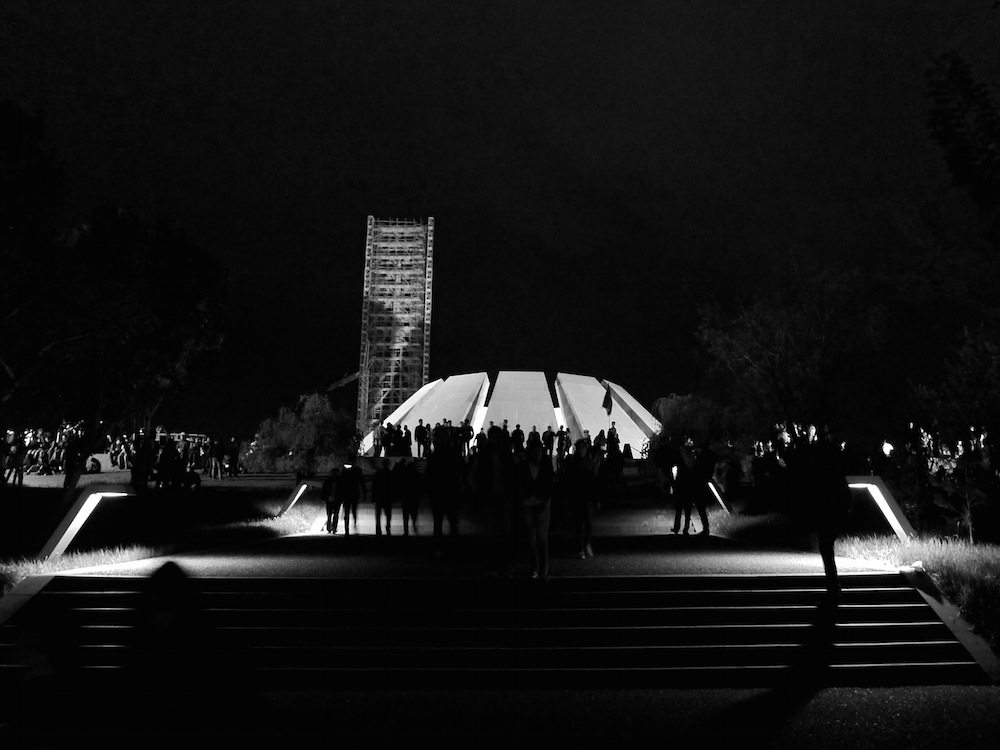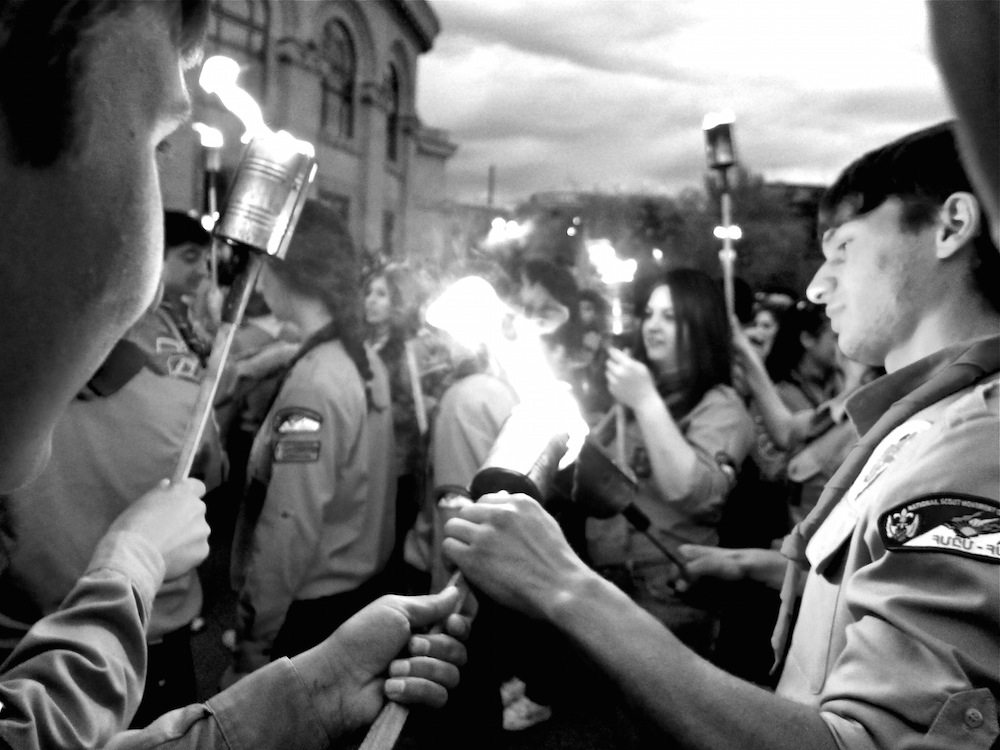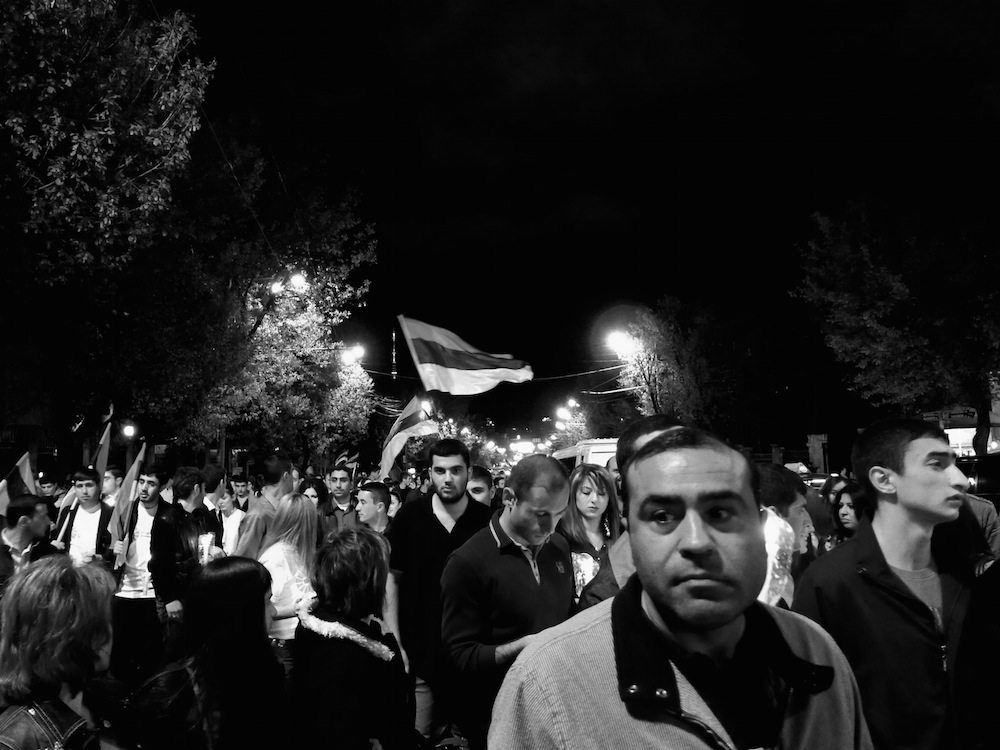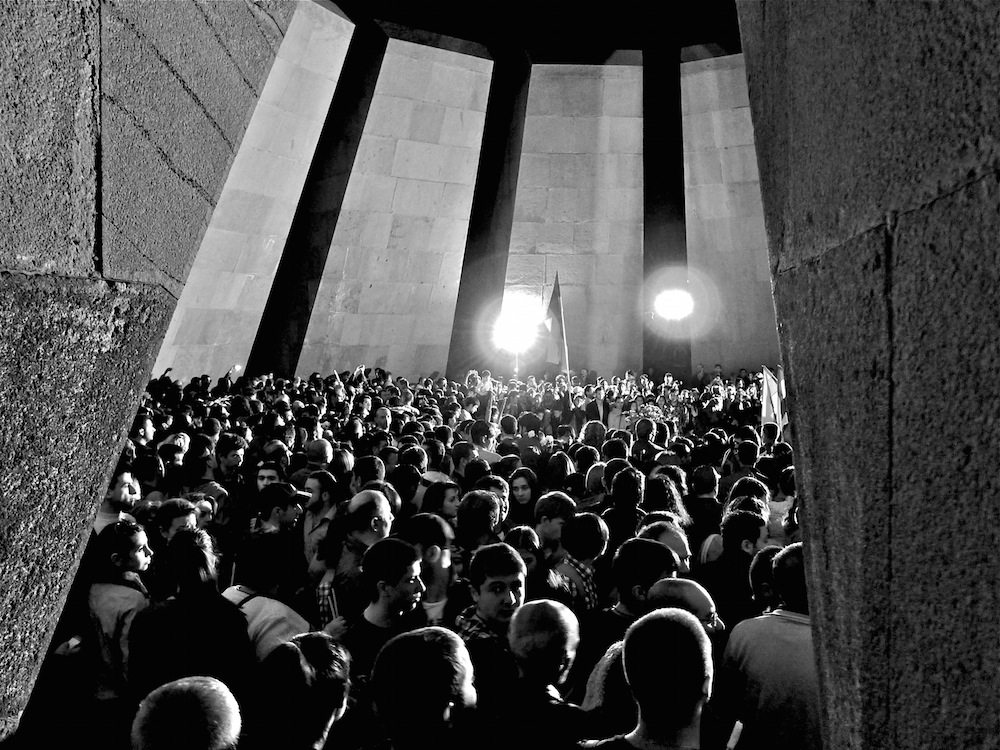Marching through the dark

It has now grown into a decade-long tradition. The commemorative walk in the Armenian capital of Yerevan, held each year on April 23. It’s late afternoon and people have slowly started to gather on Freedom Square, behind the massive grey opera building. Just as in previous years, thousands of Yerevan residents prepare to start a 5 kilometres long torchlight procession, at dusk, towards the Armenian genocide memorial located on top of the steep and uninhabited Tsitsernakaberd hill, overlooking the Hrazdan river, the national stadium and the city centre. Until night, a stream of small yellow dots will be seen traversing the large avenues of the Armenian capital, where the buildings are massive and made up of ochre tuff stones.
The first nightly demonstration in Yerevan was organised in 1999 by the Armenian Revolutionary Federation’s youth organisation. It has continued to follow a similar format, gathering not only youth but a diversity of people. The genocide, and the memory of it, remains a core formative part of Armenian identity. One of the organisers in 2005 and 2006 was Christina Gargaryan, still a student at the time. She recalls the features of the demonstration, which haven’t changed much over the years. “There is a big wooden cross leading the procession, with priests at the forefront. Then, youth holding a giant Armenian flag. While walking they sing religious and patriotic songs.”
The international Armenian Genocide Remembrance Day takes place yearly on April 24, marking the 1915 arrest and subsequent killing of the majority of the Istanbul-based Armenian leadership by the government of the Young Turks. This year, 2015, marks 100 years since the genocide. From 1915 until 1923, an estimated 1.5 million Armenians living in the Ottoman Empire were killed during the massacres and deportations ordered by the Young Turks. During the First World War, the Ottomans, supported by Germany, were fighting against the Allied Powers. In fierce battles against Britain and France in the Western Gallipoli peninsula, and against Russia on the Eastern front, Armenians throughout Anatolia were displaced, killed and dispossessed of their properties.

Each year on this day, members of Armenia’s civil society and state organisations gather for a carefully organised daytime commemoration at the Tsitsernakaberd memorial. The demonstration held the night before tends to be more spontaneous, stirring and free-flowing. The purpose is to commemorate the dead, but also to send a message – a reminder to Turkey and the world that Armenians are still waiting for justice. Neither in Armenia nor among the diaspora has the deep-rooted feeling of loss dissipated over the generations. “It’s impossible to forget,” says Christina Gargaryan. “The genocide is a frequent topic of discussion in our family. I became aware of it when I was three or four years old.”
Youth still make up the majority of the nightly participants, who begin the procession at Yerevan’s Freedom Square. Armenian scouts form lines, some of them holding the flags of international organisations or countries that have recognised the genocide, like Chile, Canada, France, Russia and the European parliament. Big speakers loaded on a small truck broadcast patriotic songs. Soon after, a member of the Armenian Revolutionary Federation, a nationalist party founded in 1890 and very active during the late years of the Ottoman Empire, ascends the stairs of the opera house to address the crowd. “The genocide continues till today. On the eve of the centenary we must swear to continue. This is only the beginning of our struggle!”
As the sun fades and darkness falls, the scouts light torches while most others carry candles in plastic bottles. The statues on the square, sombre depictions of the Armenian poet Hovhannes Tumanyan and composer Alexander Spendiaryan, melt into the darkness. The procession begins, led by a banner carried by young women that reads: “Recognition! Condemnation! Reparations!”

Since the fall of the Soviet Union, the memory of the genocide has been at the core of identity formation in the small independent republic, established on the eastern edge of the territories historically inhabited by Armenians. Anthropologist Harutyun Marutyan, who researched the resurgence of this memory in the late 1980s, says that the Soviets weren’t opposed to its commemoration. “But they wanted to keep it focused on victimhood. After the 1988 Sumgait pogrom in Azerbaijan, when Azeri mobs attacked and killed dozens of Armenian residents in the city located on the Caspian seashore, the memory of the genocide came in the foreground and became a locomotive for the independence movement. It paved the way to democratic changes. After independence, this memory was institutionalised and became part of state politics.”
A little while into the procession, the centre of Yerevan has turned dark. The crowd moves along the large Baghramyan Avenue, past the National Assembly. It’s rush hour and police must guide the dense flow of people. The atmosphere is light and joyful: friends chat and shout slogans together. Families and elders join the crowd as well and there are Armenians from all regions of the country, along with a group of students from Georgia and members of the diaspora. They exhale a mix of pride, spirituality and resilience. Many marchers wave the red, blue and orange Armenian flag; some wear it wrapped around their shoulders. A couple of Syrian flags can be as seen as well – Aleppo and other Syrian cities were home to large Armenian communities prior to the start of the civil war, many of whom are descendants of genocide survivors deported from Anatolia to the Syrian desert a century ago.
“All Armenian families are affected by the genocide,” says Christina Gargaryan, whose paternal grandparents are Aleppan Armenians repatriated after the Second World War. Her maternal grandparents are orphans who were raised in Gyumri, the second biggest Armenian city located in the north-western part of the country, from families living in today’s eastern Turkey. She has maintained connections with some Armenians still residing in Turkey. “But many live in hiding. They fear to disclose their real identities. I have a friend whose relatives live in Istanbul. They go to a Turkish-Armenian school. But in their textbooks, there is not a single word about the genocide.”
Turkey officially denies the genocidal nature of the massacres, but little is being taught elsewhere about this historical event. American-Armenian anthropologist Dana Walrath, who came to Yerevan to research the conditions of the country’s elderly population, has a grandmother who escaped a small village in eastern Anatolia during the genocide. She grew up in the United States. “It’s terrible to have a history not being recognised. I had a very good history teacher in high school. One day he asked me what he should know about Armenia, and I had to educate him about the genocide. It would be really wonderful if the Armenian genocide was part of global knowledge.”
The Armenian genocide constitutes a means through which to understand the capacity for mass violence in the modern world, a core characteristic of many conflicts since the First World War. Targeted religious or ethnic groups are not only physically annihilated, but their cultures are set to be eliminated; their existence forgotten, each of their traces erased from geographies, books and collective memory.
Yerevan, today home to a population of over one million, was a small town with a mixed population, including Armenians and Azeris, also referred to as Tatars, in the pre-Soviet era. It developed quickly following the urban changes introduced by Russian-born architect Alexander Tamanian in the 1920s. The round-shaped city centre has large perpendicular avenues and an architecture that blends the Soviet aesthetic with neoclassicism and elements from medieval Armenian monuments. Many of the peripheral neighbourhoods, towns and villages are named after places that were lost during the genocide. At night, the iconic landmark of the southern Mount Ararat disappears, only to be replaced northwards by the intimidating and illuminated gigantic statue of Mother Armenia. From key locations in the city, the outline of the genocide memorial can be seen through the darkness, next to the (architecturally no less intriguing) Karen Demirchyan sports and concerts complex.
After passing by the National Assembly, the procession enters the Arabkir district, named after the small city of Arapgir in central Anatolia. Hidden in a park at the end of a straight street is another memorial dedicated to the genocide. It has an abstract and slender shape – a futuristic look even – like many of the monuments built during the Soviet period: there is a central tower bearing the Soviet Socialist Armenian emblem, enveloped by two curved wings.
After crossing the Kievyan Bridge over the Hrazdan gorge, the large crowd arrives at the northern foothill of the Tsitsernakaberd. Street vendors sell flowers, red or white carnations mainly, which marchers buy in order to hang around the ‘eternal fire’ – a burning light that’s never allowed to die, sitting at the heart of the memorial. The walking path towards the memorial complex is steep and runs through a small forest immersed in complete darkness.

2015 marked the centenary of the Armenian genocide, with an unprecedented media attention and foreign leaders arriving in Yerevan. Yet Armenia’s tense relationship with Turkey is unlikely to ease. The border has been closed since 1993, due to the Azeri-Armenian conflict over Nagorno-Karabagh, and the recent attempt in 2008-2009 to re-establish diplomatic relations fell through. Harout Ekmanian, a young journalist working for the independent online media Civilnet, maintains a rather bleak outlook. “The centenary is not very different from the tenth year or the fiftieth year. The past will remain the same. For me, [it’s] not only about apology, there needs to be at least a restitution of memory, dignity and properties. For example, if you go to Berlin you see street signs and statues commemorating the Jewish Holocaust and the Jewish past in the city.”
Since 2010, annual commemorations have been held publicly in Turkey. “I was in Istanbul on April 24 in 2011,” continues Harout. “For me it was ‘a tale of two contradicting Turkeys.’ I participated in a silent sit-in on Taksim Square, there were like 500 people from all walks of life: religious people, Kurds, liberals, leftists… Fifteen minutes after that, there was another big rally by ultra-nationalists, with around 10,000 people marching on Istiklal Avenue. They were swearing and threatening they would come to Yerevan to kill the last Armenians.”
The issue of the genocide in Turkey is often perceived through a geopolitical lens, with foreign powers believed by some to be co-opting Armenians and other minorities as “local agents”. The recognition of the genocide is therefore seen as an attack against Turkey and Turkish identity. Those in liberal and intellectual circles who, more and more, have started to use the G-word, regularly get labelled “traitors”. For Armenians, the genocide is often a burden that can be relieved only if Turkey starts taking concrete steps towards recognition.
On top of the Tsitsernakaberd hill, the demonstrators have arrived at the memorial. They switch off their torches, assemble again in a compact crowd in the narrow alley leading straight to the museum entrance. They then turn left towards the main monuments: an arrow-shaped granite stele and 12 inward-leaning basalt slabs arranged in a circle. At this point, few voices can be heard. The marchers slowly retreat into their own bubbles. There’s a religious ceremony held within the sanctuary, with a priest in long black robes and the scouts still holding the national flags. People ascend the few stairs between the slabs to get closer to the eternal flame. They meditate for a moment, add flowers to a pile that keeps growing hour after hour, and discretely leave the memorial. Many more will continue to come and go, until very late in the night, only to begin again early next morning.






